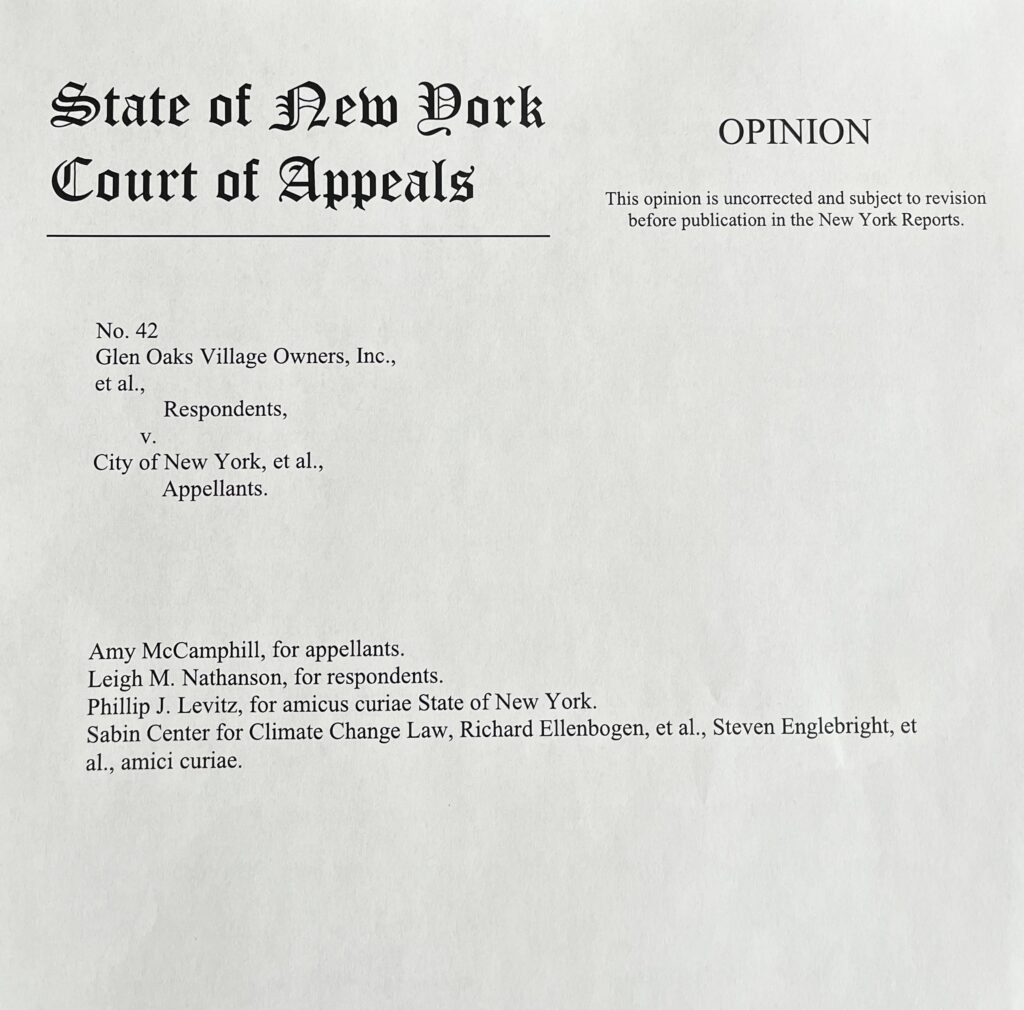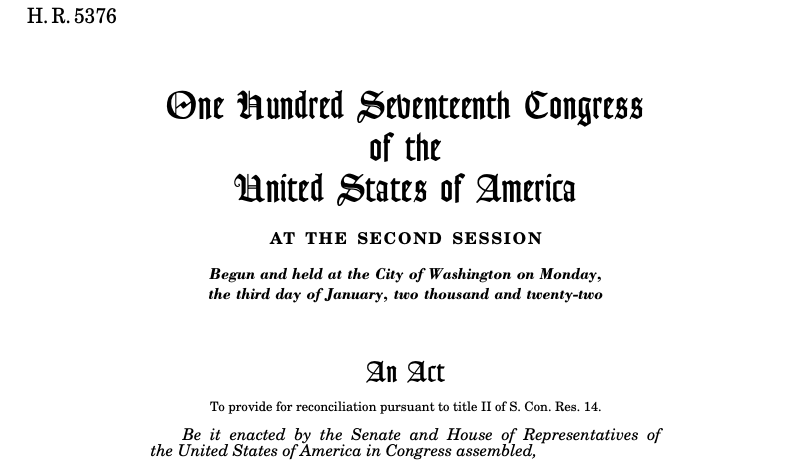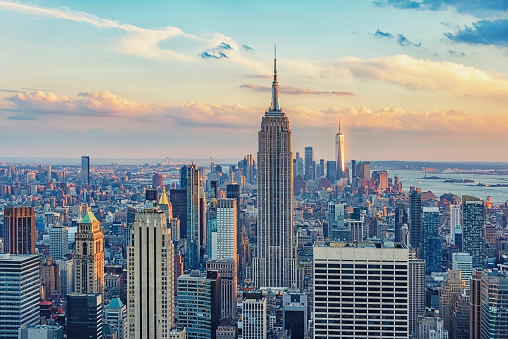Last Thursday, May 22, the New York State Court of Appeals – the State’s highest court – issued a decision upholding New York City’s Local Law 97 of 2019. Local Law 97 is one of the country’s most ambitious municipal climate policies, requiring the City’s largest buildings to comply with increasingly stringent greenhouse gas (GHG) emissions limits. The law was challenged by building owners in Glen Oaks Village Owners v. City of New York. By the time the case reached the State Court of Appeals, the key issue to be resolved was whether New York State’s Climate Leadership and Community Protection Act (CLCPA), preempts local regulation in the field of GHG emissions regulation—and therefore Local Law 97. Field preemption occurs when a state (or the federal government) occupies the regulation of a certain subject matter so extensively as to exclude local governments from regulating in that area. It is one type of preemption, the legal doctrine where a higher law displaces a lower-level law. Writing for the Court, Judge Anthony Cannataro stated plainly that “the [CLCPA] does not displace Local Law No. 97 through field preemption.”
This blog post traces the history of the case, analyzes the Court of Appeals’ decision, and contextualizes Local Law 97 within New York City’s other climate policies.
Case History: 2022-2024
Glen Oaks Village Owners v. City of New York began in 2022, when a group of cooperative apartment owners filed suit seeking to invalidate Local Law 97. The initial complaint, which brought five claims challenging Local Law 97’s lawfulness, was dismissed by the trial court. The Appellate Division, First Department, affirmed the dismissal of four of the five claims, but left open the question of whether the CLCPA preempted the field of GHG regulation within New York State, and therefore preempted Local Law 97. The Appellate division originally remanded the case to the trial court, but the City filed a Motion for Leave to Appeal directly to the New York Court of Appeals. The Appellate Division granted the motion, placing before the Court the sole question of whether the CLCPA field preempted Local Law 97.
During the appeals process, the Sabin Center submitted two amicus briefs: (1) to the First Department in June 2024 in support of the City’s Motion for Leave to Appeal to the New York Court of Appeals; and (2) to the Court of Appeals in December 2024 in support of the City’s argument that the CLCPA does not preempt Local Law 97.
The Decision: Court of Appeals Finds No Field Preemption
In New York, field preemption can be express or implied (for a brief summarization of the preemption legal doctrine, see our December 2024 blog post). As explained in DJL Rest. Corp. v. City of New York, 96 N.Y.2d 91, 95 (2001), “an implied intent to preempt may be found in a ‘declaration of State policy by the State Legislature or from the fact that the Legislature has enacted a comprehensive and detailed regulatory scheme in a particular area.’”
Plaintiffs in the Glen Oaks case claimed that the CLCPA impliedly field preempts Local Law 97. They asserted that the “nature and statewide significance of the subject matter being regulated”—i.e., GHG emissions—evidenced a need for regulatory uniformity and that the CLCPA “demonstrate[ed] an intent [on the part of the state legislature] to preempt the field of regulating greenhouse gas emissions.” The Court rejected that argument, and concluded the opposite: the CLCPA recognizes the “important role” that local governments play in regulating GHG emissions. The Court identified an urgency within the CLCPA’s legislative findings to swiftly reduce emissions, including “encourag[ing] other jurisdictions to implement complementary greenhouse gas reduction strategies.” Absent from the legislative findings, it noted, was any indication that the legislature desired “across-the-board uniformity” with respect to emissions reductions. Further, the Court found the “absence of any statement that local efforts would be superseded” especially significant, as Local Law 97 was enacted several months before the CLCPA.
Plaintiffs also argued that two provisions of the CLCPA, when read together, demonstrated the legislature’s intent to preempt the field of regulating GHG emissions. The first, CLCPA § 10, preserves the existing authority of state entities to “adopt and implement greenhouse gas emissions reduction measures.” The second is CLCPA § 11, a savings clause that requires all state entities to comply with other applicable local laws and regulations. Plaintiffs contended that reading both provisions together implied that the savings clause excluded local laws addressing GHG emissions reduction measures. The Appellate Division, First Department’s May 2024 ruling stated “one could conclude” as much. The State Court of Appeals dismissed this argument, finding that the provisions are not meant to be read together because they do not cover the same subject matter. Even assuming Plaintiffs’ read of the two provisions was correct, Judge Cannataro explained “it is nonetheless insufficient to show a clearly evinced intent to preempt the field.”
In sum, the Court of Appeals firmly agreed with the City, accepting the validity of their legal argument that the CLCPA represents an “all-hands-on-deck” approach to aspirational and future-oriented emissions reduction goals that leaves the “mechanism of [achieving] those goals to further study and eventual regulation.” In other words, the CLCPA is not so extensively detailed as to supplant all local regulation in the area, especially where, like here, a local law furthers the State’s policy interests. And, the language of CLCPA § 10 and § 11 does not require a different result.
This is the first definitive stamp of approval by a state’s highest court for building performance standards that explicitly target GHG emissions reductions. While the Court’s decision is not binding on any other state jurisdictions, the rejection of all five of Plaintiffs’ claims is encouraging for local climate action across the country, and positions building performance standards as viable, scalable legal pathways to decarbonization. Further, the Court’s finding that a statewide climate law does not preempt the field of greenhouse gas regulation may provide persuasive authority if preemption challenges are brought against similar state climate laws.
New York City’s Growing Suite of Climate Policies
Local Law 97 is one of several local laws aimed at reducing New York City’s GHG emissions. New York City has addressed transportation sector emissions through the implementation of congestion pricing, which, in its first months, has been very successful. A federal judge recently barred the U.S. Department of Transportation from withholding funds while litigation over the tolling scheme plays out. On the building side, in addition to Local Law 97, the City enacted Local Law 154 in 2021 to prohibit fossil fuel combustion in most new buildings. That law, challenged by plumbing and building trade groups, recently received a favorable decision in the United States District Court for the Southern District of New York. The City Council is also considering a bill that would require the Department of Environmental Protection to promulgate a rule to regulate indirect sources of air pollution. The City cannot directly regulate vehicle emissions due to Clean Air Act preemption, but it can regulate indirect sources like e-commerce warehouses. The rule would include measures such as requiring indirect sources to implement air pollution mitigation plans, regulating delivery times or methods, establishing incentives for pollution mitigation, and imposing penalties for violations.
Each of these laws will help the City reduce GHG emissions by 80 percent by 2050, as required by Local Law 66 of 2014. As noted by Plaintiffs and the Court, local laws also contribute to the achievement of the State’s goal of reducing GHG emissions by 85 percent from 1990 levels by 2050. Meeting this goal will require an “all-hands-on deck” approach. The Court of Appeals’ ruling enables just that.
Vincent M. Nolette is the Sabin Center's Equitable Cities Climate Law Fellow.





